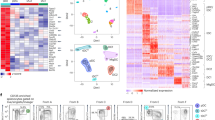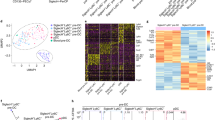Abstract
Two subsets of dendritic cell (DCs), plasmacytoid (p) and myeloid (m) DCs, have been described in humans and mice. These subsets are known to have divergent roles during an immune response, but their developmental course is unclear. Here we report that virus infection induces bone marrow pDCs to differentiate into mDCs, thereby undergoing profound phenotypic and functional changes including the acquisition of enhanced antigen-presenting capacity and the ability to recognize different microbial structures through Toll-like receptor 4. The conversion of pDCs into mDCs is also induced by the injection of double-stranded RNA and requires type I interferons. Our results establish a precursor-product developmental relationship between these two DC subsets and highlight unexpected plasticity of bone marrow pDCs.
This is a preview of subscription content, access via your institution
Access options
Subscribe to this journal
Receive 12 print issues and online access
$209.00 per year
only $17.42 per issue
Buy this article
- Purchase on Springer Link
- Instant access to full article PDF
Prices may be subject to local taxes which are calculated during checkout







Similar content being viewed by others
References
Reis e Sousa, C. Activation of dendritic cells: translating innate into adaptive immunity. Curr. Opin. Immunol. 16, 21–25 (2004).
Reis e Sousa, C. Toll-like receptors and dendritic cells: for whom the bug tolls. Semin. Immunol. 16, 27–34 (2004).
Ardavin, C., Amigorena, S. & Reis e Sousa, C. Dendritic cells: immunobiology and cancer immunotherapy. Immunity 20, 17–23 (2004).
Banchereau, J. et al. Dendritic cells: controllers of the immune system and a new promise for immunotherapy. Ann. NY Acad. Sci. 987, 180–187 (2003).
Cerundolo, V., Hermans, I.F. & Salio, M. Dendritic cells: a journey from laboratory to clinic. Nat. Immunol. 5, 7–10 (2004).
Lu, W., Wu, X., Lu, Y., Guo, W. & Andrieu, J.M. Therapeutic dendritic-cell vaccine for simian AIDS. Nat. Med. 9, 27–32 (2003).
Shortman, K. & Liu, Y.J. Mouse and human dendritic cell subtypes. Nat. Rev. Immunol. 2, 151–161 (2002).
D'Amico, A. & Wu, L. The early progenitors of mouse dendritic cells and plasmacytoid predendritic cells are within the bone marrow hemopoietic precursors expressing Flt3. J. Exp. Med. 198, 293–303 (2003).
Karsunky, H., Merad, M., Cozzio, A., Weissman, I.L. & Manz, M.G. Flt3 ligand regulates dendritic cell development from Flt3+ lymphoid and myeloid-committed progenitors to Flt3+ dendritic cells in vivo. J. Exp. Med. 198, 305–313 (2003).
Traver, D. et al. Development of CD8α-positive dendritic cells from a common myeloid progenitor. Science 290, 2152–2154 (2000).
Dalod, M. et al. Dendritic cell responses to early murine cytomegalovirus infection: subset functional specialization and differential regulation by interferon α/β. J. Exp. Med. 197, 885–898 (2003).
Kadowaki, N. & Liu, Y.J. Natural type I interferon-producing cells as a link between innate and adaptive immunity. Hum. Immunol. 63, 1126–1132 (2002).
Martin, P. et al. Characterization of a new subpopulation of mouse CD8α+B220+ dendritic cells endowed with type 1 interferon production capacity and tolerogenic potential. Blood 100, 383–390 (2002).
Nakano, H., Yanagita, M. & Gunn, M.D. CD11c+B220+Gr-1+ cells in mouse lymph nodes and spleen display characteristics of plasmacytoid dendritic cells. J. Exp. Med. 194, 1171–1178 (2001).
Asselin-Paturel, C. et al. Mouse type I IFN-producing cells are immature APCs with plasmacytoid morphology. Nat. Immunol. 2, 1144–1150 (2001).
Gilliet, M. et al. The development of murine plasmacytoid dendritic cell precursors is differentially regulated by FLT3-ligand and granulocyte/macrophage colony-stimulating factor. J. Exp. Med. 195, 953–958 (2002).
Ito, T. et al. Interferon-α and interleukin-12 are induced differentially by Toll-like receptor 7 ligands in human blood dendritic cell subsets. J. Exp. Med. 195, 1507–1512 (2002).
Mazzoni, A. & Segal, D.M. Controlling the Toll road to dendritic cell polarization. J. Leukoc. Biol. 75, 721–730 (2004).
Ahmed, R. & Oldstone, M.B. Organ-specific selection of viral variants during chronic infection. J. Exp. Med. 167, 1719–1724 (1988).
Oldstone, M.B., Salvato, M., Tishon, A. & Lewicki, H. Virus-lymphocyte interactions. III. Biologic parameters of a virus variant that fails to generate CTL and establishes persistent infection in immunocompetent hosts. Virology 164, 507–516 (1988).
Salvato, M., Shimomaye, E., Southern, P. & Oldstone, M.B. Virus-lymphocyte interactions. IV. Molecular characterization of LCMV Armstrong (CTL+) small genomic segment and that of its variant, clone 13 (CTL−). Virology 164, 517–522 (1988).
Jacobs, B.L. & Langland, J.O. When two strands are better than one: the mediators and modulators of the cellular responses to double-stranded RNA. Virology 219, 339–349 (1996).
Shigematsu, H. et al. Plasmacytoid dendritic cells activate lymphoid-specific genetic programs irrespective of their cellular origin. Immunity 21, 43–53 (2004).
Corcoran, L. et al. The lymphoid past of mouse plasmacytoid cells and thymic dendritic cells. J. Immunol. 170, 4926–4932 (2003).
O'Keeffe, M. et al. Mouse plasmacytoid cells: long-lived cells, heterogeneous in surface phenotype and function, that differentiate into CD8+ dendritic cells only after microbial stimulus. J. Exp. Med. 196, 1307–1319 (2002).
Asselin-Paturel, C., Brizard, G., Pin, J.J., Briere, F. & Trinchieri, G. Mouse strain differences in plasmacytoid dendritic cell frequency and function revealed by a novel monoclonal antibody. J. Immunol. 171, 6466–6477 (2003).
Boonstra, A. et al. Flexibility of mouse classical and plasmacytoid-derived dendritic cells in directing T helper type 1 and 2 cell development: dependency on antigen dose and differential toll-like receptor ligation. J. Exp. Med. 197, 101–109 (2003).
Diebold, S.S., Kaisho, T., Hemmi, H., Akira, S. & Reis e Sousa, C. Innate antiviral responses by means of TLR7-mediated recognition of single-stranded RNA. Science 303, 1529–1531 (2004).
Bjorck, P. Isolation and characterization of plasmacytoid dendritic cells from Flt3 ligand and granulocyte-macrophage colony-stimulating factor–treated mice. Blood 98, 3520–3526 (2001).
Beignon, A.S., Skoberne, M. & Bhardwaj, N. Type I interferons promote cross-priming: more functions for old cytokines. Nat. Immunol. 4, 939–941 (2003).
Le Bon, A. & Tough, D.F. Links between innate and adaptive immunity via type I interferon. Curr. Opin. Immunol. 14, 432–436 (2002).
Lee, C.K. et al. Generation of macrophages from early T progenitors in vitro. J. Immunol. 166, 5964–5969 (2001).
Izon, D. et al. A common pathway for dendritic cell and early B cell development. J. Immunol. 167, 1387–1392 (2001).
Bjorck, P. & Kincade, P.W. CD19+ pro-B cells can give rise to dendritic cells in vitro. J. Immunol. 161, 5795–5799 (1998).
Ardavin, C. Origin, precursors and differentiation of mouse dendritic cells. Nat. Rev. Immunol. 3, 582–590 (2003).
Comeau, M.R., Van der Vuurst de Vries, A.R., Maliszewski, C.R. & Galibert, L. CD123bright plasmacytoid predendritic cells: progenitors undergoing cell fate conversion? J. Immunol. 169, 75–83 (2002).
Koo, C.H. et al. Additional evidence that 'plasmacytoid T-cell lymphoma' associated with chronic myeloproliferative disorders is of macrophage/monocyte origin. Am. J. Clin. Pathol. 93, 822–827 (1990).
Chaperot, L. et al. Identification of a leukemic counterpart of the plasmacytoid dendritic cells. Blood 97, 3210–3217 (2001).
Diebold, S.S. et al. Viral infection switches non-plasmacytoid dendritic cells into high interferon producers. Nature 424, 324–328 (2003).
Sevilla, N., McGavern, D.B., Teng, C., Kunz, S. & Oldstone, M.B. Viral targeting of hematopoietic progenitors and inhibition of DC maturation as a dual strategy for immune subversion. J. Clin. Invest. 113, 737–745 (2004).
Ichikawa, E. et al. Defective development of splenic and epidermal CD4+ dendritic cells in mice deficient for IFN regulatory factor-2. Proc. Natl. Acad. Sci. USA 101, 3909–3914 (2004).
Honda, K., Mizutani, T. & Taniguchi, T. Negative regulation of IFN-α/β signaling by IFN regulatory factor 2 for homeostatic development of dendritic cells. Proc. Natl. Acad. Sci. USA 101, 2416–2421 (2004).
Dutko, F.J. & Oldstone, M.B. Genomic and biological variation among commonly used lymphocytic choriomeningitis virus strains. J. Gen. Virol. 64, 1689–1698 (1983).
Schlissel, M.S., Corcoran, L.M. & Baltimore, D. Virus-transformed pre-B cells show ordered activation but not inactivation of immunoglobulin gene rearrangement and transcription. J. Exp. Med. 173, 711–720 (1991).
Acknowledgements
This is publication no. 16635-NP from the Division of Virology, Department of Neuropharmacology, TSRI. We thank A. O'Garra and A. Boonstra for suggestions; Amgen for human recombinant Flt3L; and personnel of the TSRI Flow Cytometry Facility, especially C. Silao, for technical assistance with cell sorting. This work was supported by grants from the US Public Health Service (AI45927 and AI09484). E.I.Z. was supported by Pew Foundation Latin American Fellowship and Fundacion Antorchas.
Author information
Authors and Affiliations
Corresponding author
Ethics declarations
Competing interests
The authors declare no competing financial interests.
Supplementary information
Supplementary Fig. 1
Expression of Ly6C and Gr-1 on pDCs. (PDF 180 kb)
Supplementary Fig. 2
Spleen pDCs from poly(I:C)-injected mice do not convert into mDCs. (PDF 130 kb)
Supplementary Fig. 3
FACS-purified BM CD11c+120G8+CD11b−B220+Ly6C+ pDCs were obtained from Poly(I:C) injected mice. (PDF 114 kb)
Supplementary Fig. 4
mCDs derived from pDCs can respond to TLR-4 stimulation. (PDF 194 kb)
Rights and permissions
About this article
Cite this article
Zuniga, E., McGavern, D., Pruneda-Paz, J. et al. Bone marrow plasmacytoid dendritic cells can differentiate into myeloid dendritic cells upon virus infection. Nat Immunol 5, 1227–1234 (2004). https://doi.org/10.1038/ni1136
Received:
Accepted:
Published:
Issue Date:
DOI: https://doi.org/10.1038/ni1136
This article is cited by
-
Passive carriage of rabies virus by dendritic cells
SpringerPlus (2013)
-
Lipopolysaccharide-pretreated plasmacytoid dendritic cells ameliorate experimental chronic kidney disease
Kidney International (2012)
-
Adenovirus-mediated heme oxygenase-1 gene transfer to neonatal porcine islet-like cluster cells: the effects on gene expression and protection from cell stress
BioChip Journal (2012)
-
Mucosal dendritic cell diversity in the gastrointestinal tract
Cell and Tissue Research (2011)



